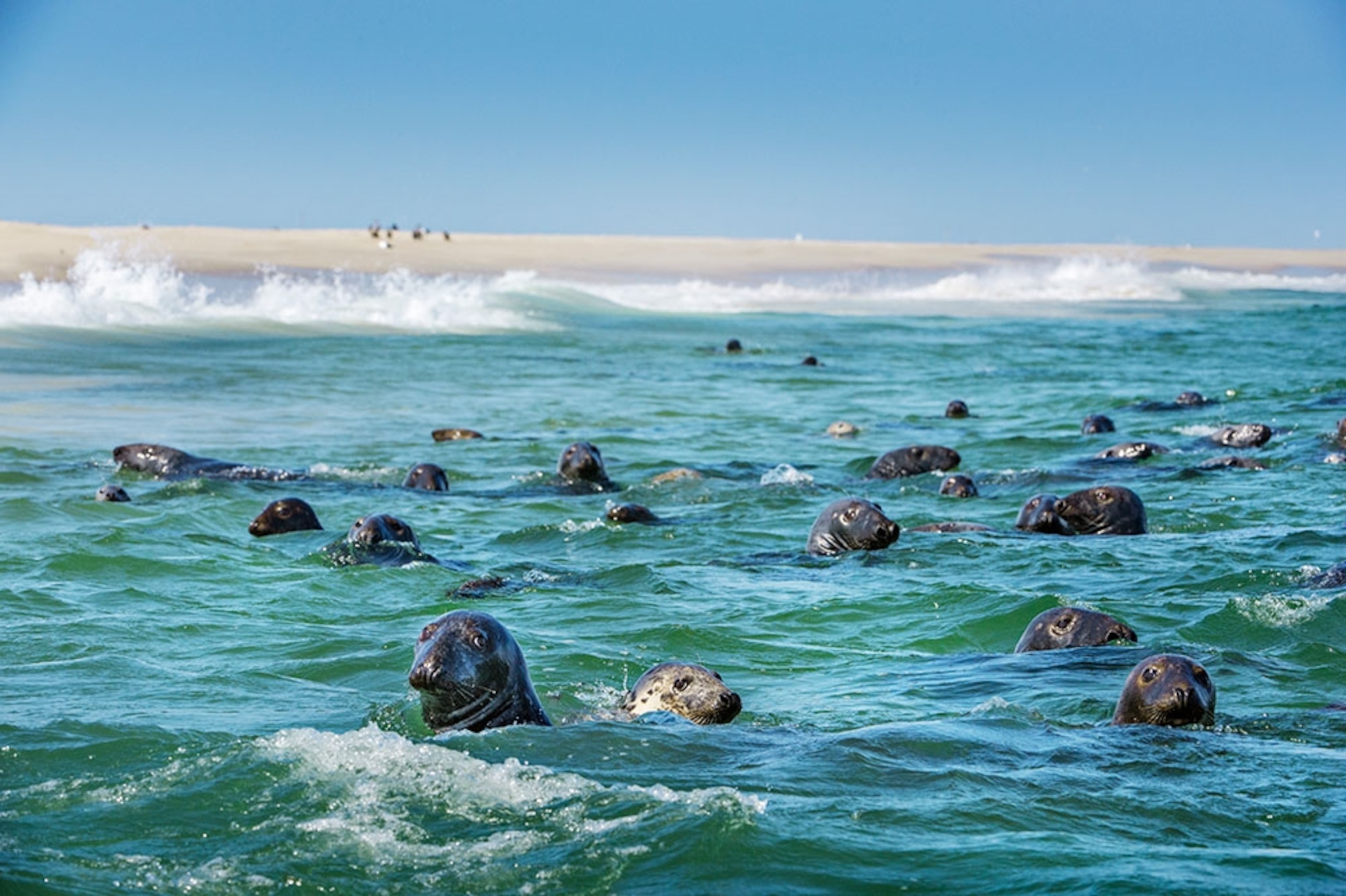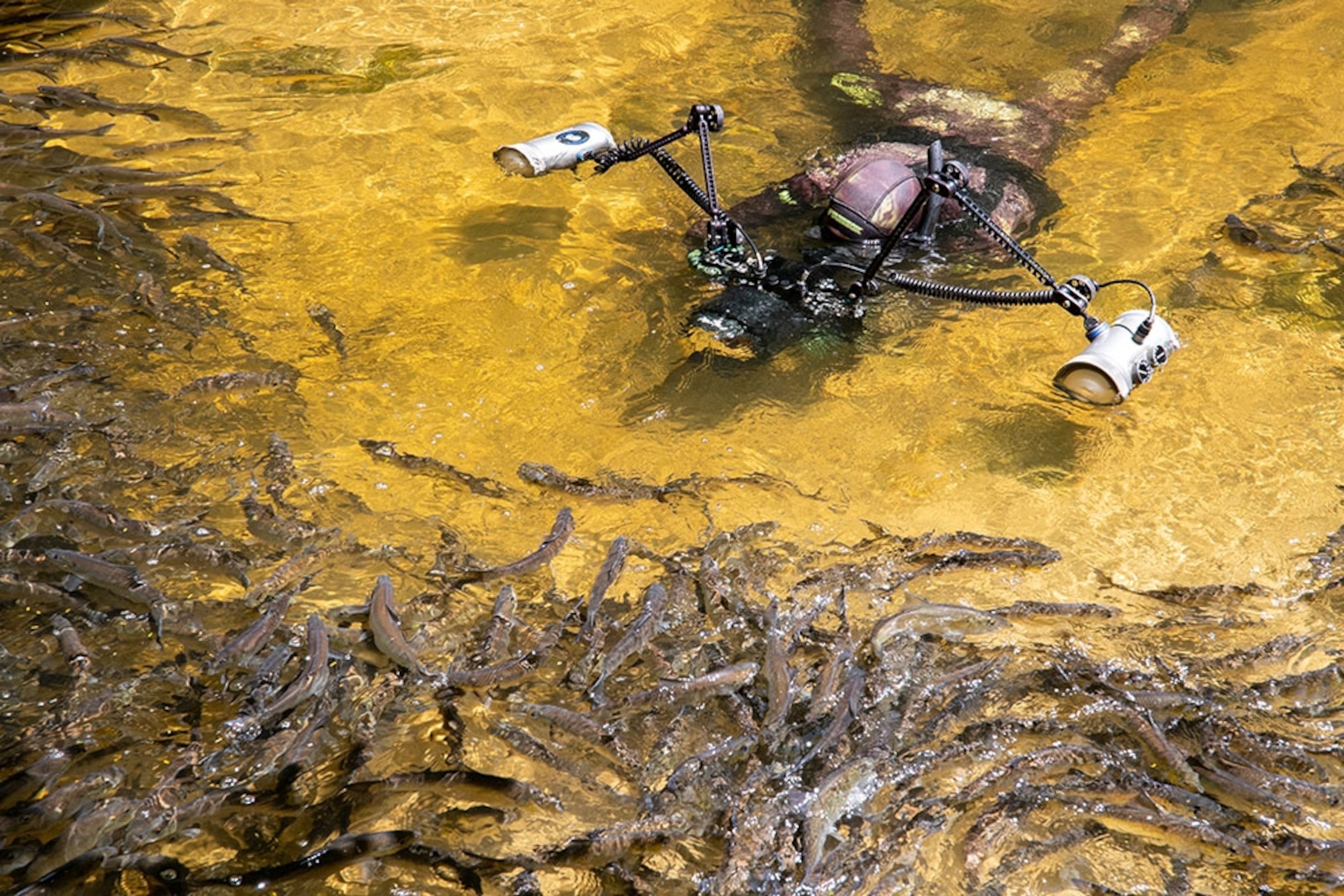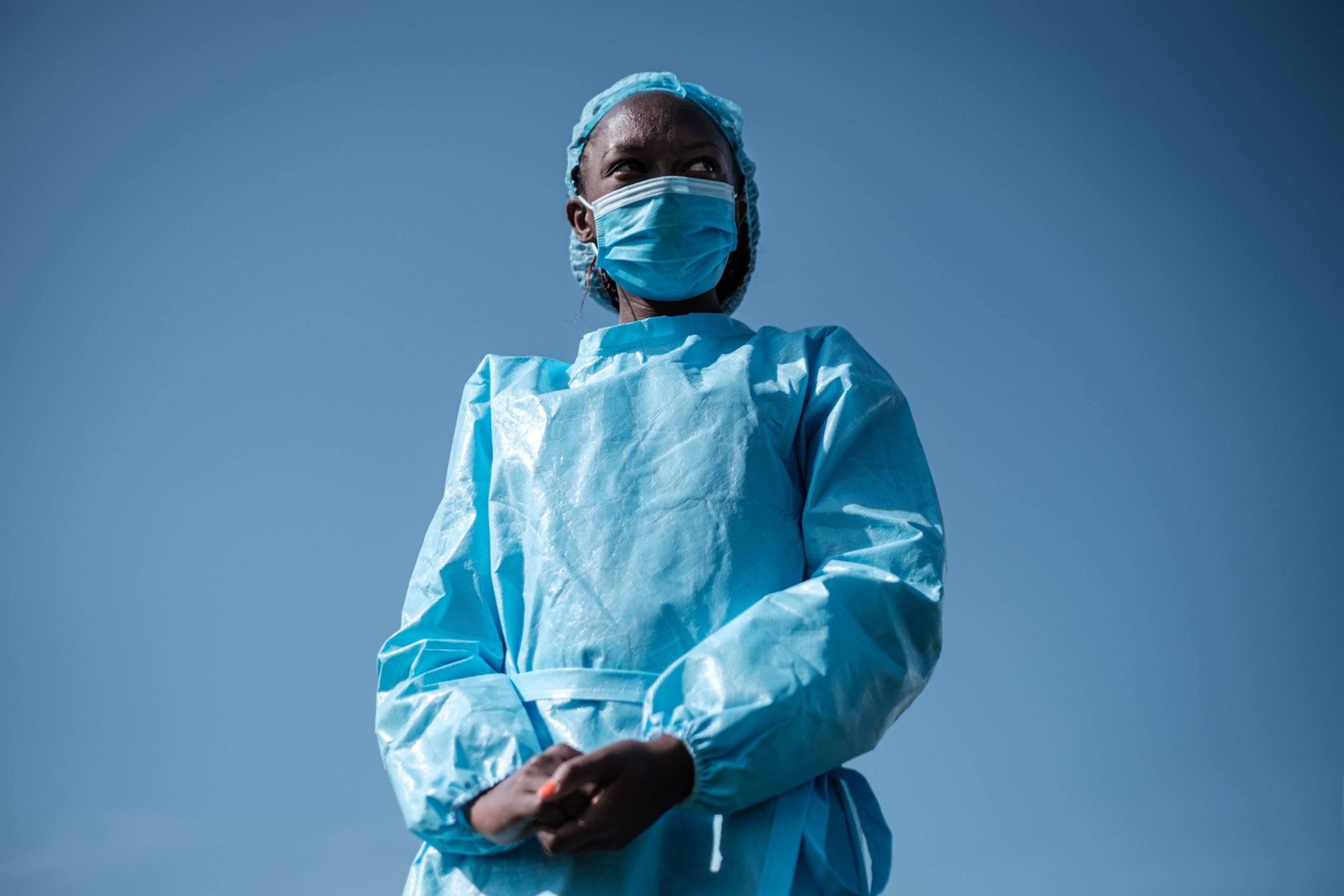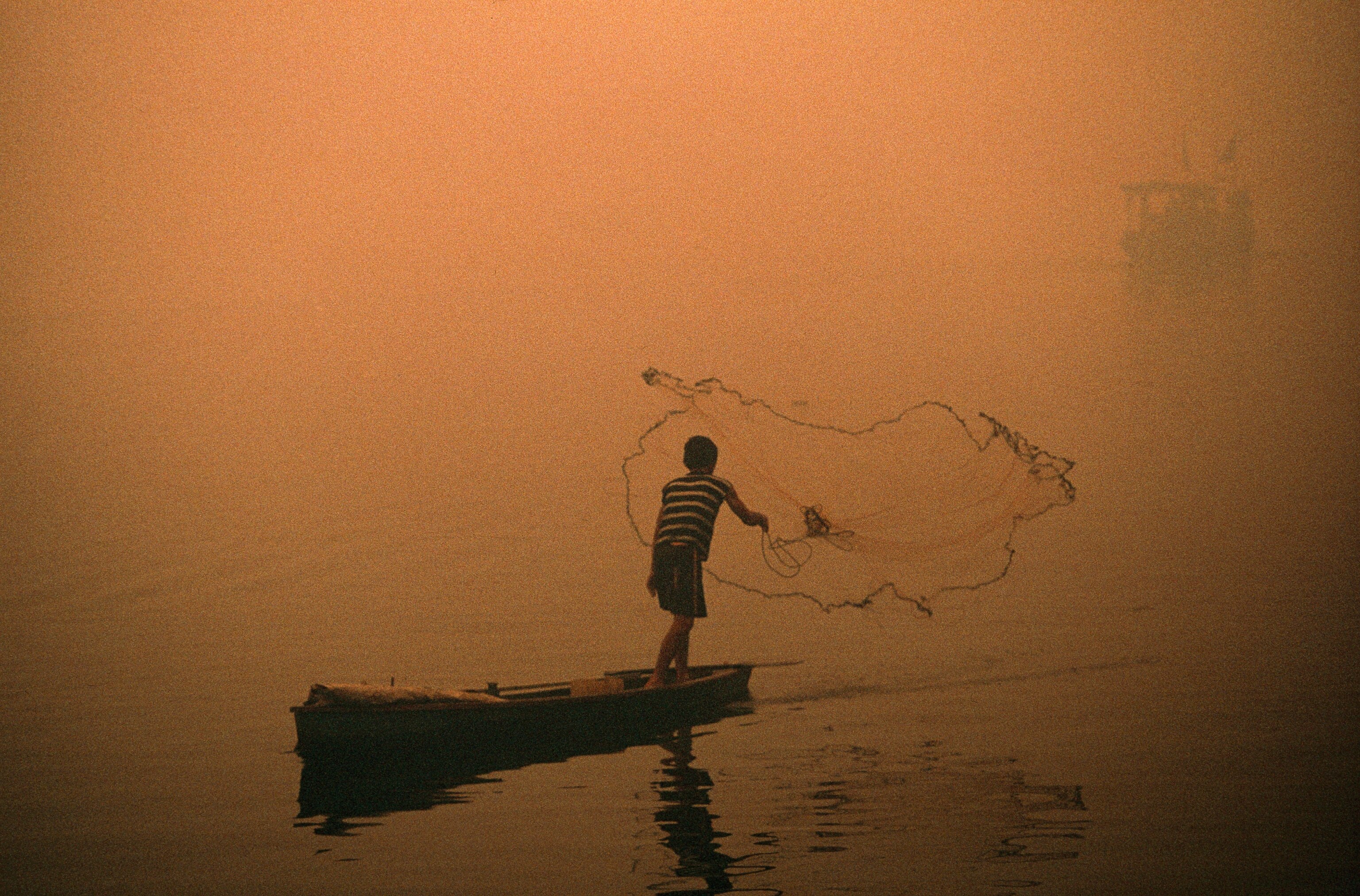
Photographing sharks, carefully
By Whitney Johnson, Director of Visual and Immersive Experiences
It’s that time of year. SharkFest. Retro showings of Jaws at suddenly more popular drive-in theaters. On Monday, however, came a somber midsummer note: the first fatal shark attack off Maine ever reported.
Photographer Brian Skerry, who has spent more than 10,000 hours diving, has been documenting sharks for years, sometimes in a cage as the fearsome creatures approached. He knows one environmental success—the rebound in shark populations off Cape Cod and Maine—is partly because of the bounce-back of its favorite meal, seal.
Long before the attack, Brian had been documenting the relationship between shark and seal. In the image above, off Cape Cod, Brian placed a camera in a seal decoy he designed and built to get the image of a shark eyeing what it thought could be dinner. Below, he captured an aerial view of gray seals near a Cape Cod beach—and, in the same image, farther out in the water, a single great white shark on the hunt. Authorities think a shark mistook the victim of Monday’s attack for a seal.

"As the white shark population rebounds and seal populations rebound, this predator-prey relationship is going to re-emerge anywhere these two species overlap,” Greg Skomal, a leading Atlantic great white shark expert, tells Nat Geo. Below, a crush of gray seals along Monomoy Island, off the Cape Cod town of Chatham, Massachusetts.

These days, Brian has been on assignment diving off the coast of New Hampshire and Maine, focusing on lobsters and colorful anemones. He says he won’t linger near the surface (where sharks feed on seals), but acknowledges he’s “very concerned.” “The notion of diving in cold waters, with limited visibility, having my head buried in my viewfinder, focusing on a lobster on the sea floor and looking up to see a great white shark near me is very unnerving,” he told us Thursday evening.
Sharks of any kind rarely attack humans, and that’s been his experience. “I’ve made many hundreds, perhaps thousands of shark dives over the years and have only had maybe three-four times where I felt that I needed to get out of the water because it became unsafe.”
Still, he urges great caution to beachgoers near waters where great whites have been spotted, discouraging swimming, surfing or even boogie boarding. Here’s Brian (below) in quieter waters, with his camera and underwater lights, photographing a school of alewife on their annual migration up Mill Brook in Westbrook, Maine.
Do you get this newsletter daily? If not, sign up here or forward to a friend.

Today in a minute

The hajj like you’ve never seen it: Usually it’s a massive crowd in Mecca, at the holy center of Islam. This year, however, images from the hajj (above) in Saudi Arabia show tightly choreographed, socially distanced pilgrimage and worship. Because of COVID-19, the annual hajj began Tuesday with 1,000 pilgrims, instead of the usual two million, CNN reports. Watch this short clip of pilgrims circling the Kaaba, Isam’s holiest shrine.
Close to home: Growing up, Anastasia Taylor-Lind equated war photography with scenes far away from her Westernized experience. Then, in February 2014, the photographer found herself in the middle of a massive protest in the cosmopolitan Ukrainian capital of Kyiv. On that day, sharpshooters killed scores of pro-democracy protesters—and Taylor-Lind realized war could happen anywhere, she told Nat Geo’s Peter Gwin in the latest episode of our podcast, Overheard. Taylor-Lind, whose first years were with her hippie parents in a horse-drawn carriage traveling throughout England, is fascinating.
Fighting the male gaze: Men and some white women have dominated world photography, and the visual concept that people glean from a place. That’s the issue that has bound together 11 female and nonbinary Latin American photographers. “We're connected through the stories that, even though they might not make it to the front page of a newspaper, are nevertheless worthy of being told,” Ecuador's Isadora Romero tells NPR. See examples of their work here.
Absorbing: Houston TV anchor Shannon LaNier found himself part of a Smithsonian Magazine spread of American historical descendants and their ancestors. He is a descendant of Thomas Jefferson and Sally Hemings, whom Jefferson had enslaved. LaNier chose not to wear a wig for the side-by-side re-creations by photographer Drew Gardner. “I didn’t want to become Jefferson,” LaNier tells Smithsonian. See the images.
Your Instagram of the day

Reinforcements: A quick break after two months of intense work for Caroline and Yasmina. Both nurses came as reinforcements to the COVID intensive care unit at Ambroise Paré hospital in Mons, Belgium. For a few weeks the COVID-19 death rate in the country was the highest in the world. This image was created with support from the National Geographic Society COVID-19 Emergency Fund.
Are you among our 141 million Instagram followers? (Why not follow us now?)
The big takeaway

Fighting COVID-19: Look around, people. Chances are the front-line health workers, nursing home care givers or community activists in the worldwide fight against the deadly virus are women. As Rachel Jones writes for Nat Geo: “Women are logging long hours managing the fallout of COVID-19, while juggling their own childcare and family responsibilities throughout the pandemic.” Why so many women? “People who have historically been on the outside transform a situation,” says Winnie Byanyima, executive director of the UNAIDS, which has offices in 70 countries. Above, Elizabeth Wanjiru, a Red Cross nurse, stands as she is introduced during a celebration of nurses at a COVID-19 field hospital in Machakos, Kenya.
In a few words
I swam with my first shark in the 1980s. I was 20 miles off the coast of Rhode Island, working with a group of marine scientists. Late in the day, a 5-foot long blue shark swam into our chum slick. For the next hour, I marveled at the animal's stunning indigo color and the elegant way she moved effortlessly through the sea.Brian Skerry, Nat Geo photographer, from Shark
Did a friend forward this to you?
On Mondays, Debra Adams Simmons covers the latest in history. If you’re not a subscriber, sign up here to also get Victoria Jaggard on science, George Stone on travel, and Rachael Bale on animal and wildlife news.
The last glimpse

Glow: In the late 1990s, a late wet season combined with slash and burning of forests to create highly polluted air in Indonesia. Amid the fires, Michael S. Yamashita photographed a fisherman casting a net with a ship looming in the distance. What attracts our senior photo archivist, Sara Manco, to this unpublished image in our files? “The orange glow of the smog gives this photo an eerie feeling,” Manco says, “and the dots of film grain add a rawness often lost by crisp digital images."
Here’s more on Mike Yamashita’s award-winning work
See: 19 striking images from Indonesia
